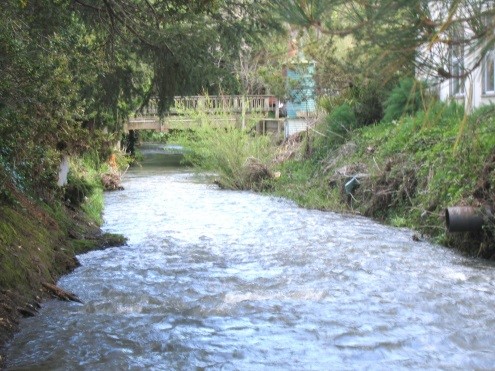
Marin County Flood Control and Water Conservation District, located in northern California, has engaged Stetson in a multi-year professional services contract to provide continued on-call hydrology, hydraulic, and engineering services in connection with design and implementation of the Ross Valley Flood and Watershed Program. Several of the projects are highlighted here.
Ross Valley Flood Reduction and Creek Management Capital Improvement Plan Study
 Stetson Engineers prepared the Ross Valley CIP master plan study for the County of Marin. The CIP followed a multidisciplinary approach to flood reduction and environmental restoration, drawing from hydrology, fluvial geomorphology, civil, structural, geotechnical, and coastal engineering, and biology. It employed two principal methods to contain the 1-percent-annual-chance flood: (1) increase the conveyance capacity of the channel; and (2) reduce the peak discharge by attenuating flood flows in large detention basins. Stetson developed a HEC-HMS watershed hydrologic model to simulate flow hydrographs and evaluate peak discharge attenuation benefits by detention basins. Stetson also developed a HEC-RAS in-channel model of the creek hydraulics to simultaneously analyze, design, and test the effectiveness of concepts that increase channel capacity. A MIKE FLOOD model (which integrates 1-D MIKE 11 in-channel model and 2-D MIKE 21 floodplain model) was used to simulate overbank flow hydraulics and conduct floodplain mapping. Fluvial geomorphic reasoning was applied during this “design-modeling” procedure to arrive at in-channel measures that are geomorphically sustainable in the creek environment. The detailed and optimized suite of measures work in concert with detention basins and the pending Army Corps Unit 4 project to bring 100-year level of flood protection to all Ross Valley communities. The CIP also considered multiple flood bypass alternatives, benefits of sediment source site reduction in upper watershed areas, and relative or additional benefits and cost-effectiveness of low impact development retrofits. Stetson made presentations at town hearings and community meetings to describe the CIP to town councils and the public. Please see www.rossvalleywatershed.org for more information.
Stetson Engineers prepared the Ross Valley CIP master plan study for the County of Marin. The CIP followed a multidisciplinary approach to flood reduction and environmental restoration, drawing from hydrology, fluvial geomorphology, civil, structural, geotechnical, and coastal engineering, and biology. It employed two principal methods to contain the 1-percent-annual-chance flood: (1) increase the conveyance capacity of the channel; and (2) reduce the peak discharge by attenuating flood flows in large detention basins. Stetson developed a HEC-HMS watershed hydrologic model to simulate flow hydrographs and evaluate peak discharge attenuation benefits by detention basins. Stetson also developed a HEC-RAS in-channel model of the creek hydraulics to simultaneously analyze, design, and test the effectiveness of concepts that increase channel capacity. A MIKE FLOOD model (which integrates 1-D MIKE 11 in-channel model and 2-D MIKE 21 floodplain model) was used to simulate overbank flow hydraulics and conduct floodplain mapping. Fluvial geomorphic reasoning was applied during this “design-modeling” procedure to arrive at in-channel measures that are geomorphically sustainable in the creek environment. The detailed and optimized suite of measures work in concert with detention basins and the pending Army Corps Unit 4 project to bring 100-year level of flood protection to all Ross Valley communities. The CIP also considered multiple flood bypass alternatives, benefits of sediment source site reduction in upper watershed areas, and relative or additional benefits and cost-effectiveness of low impact development retrofits. Stetson made presentations at town hearings and community meetings to describe the CIP to town councils and the public. Please see www.rossvalleywatershed.org for more information.
Phoenix Lake Retrofit
The keystone measure of the CIP study is the Phoenix Lake Integrated Water Management Project, which consists of seismic upgrades and improvements to the outlet works of the existing dam to enable dual use for water supply and flood control operations. Phoenix Lake is located along the Ross Creek which is tributary to Corte Madera Creek which is designated critical habitat for coho salmon and coastal steelhead. Stetson designed improvements to the outlet works to enable release of cool water from the lake hypolimnion to enhance aquatic habitat conditions for salmonids and other coldwater species. Stetson conducted hydrologic analyses of reservoir operations to evaluate instream releases from the dam that are protective of salmonid habitat. Stetson prepared an application for $7.6 million in grant funding under Prop 1E, which DWR recently awarded to FZ9. HEC-HMS hydrologic modeling, HEC-RAS 1-dimensional hydraulic modeling, MIKEFLOOD 2-dimensional hydraulic modeling, and reservoir operations modeling were developed and used for the study.
Ross Valley HEC-RAS Model Upgrade
In 2017 Stetson upgraded the existing Ross Valley HEC-RAS 1D steady-state hydraulic model, previously developed by Stetson in version 4.1, to a combined 1D/2D HEC-RAS unsteady-state hydraulic model using the recently-released version 5.0. The model upgrade also included expanding the existing model domain upstream along major tributaries hydraulically connected to proposed upper watershed detention basins that are currently under CEQA environmental review.
Stetson calibrated the model to the December 15, 2016 bankfull event and the December 31, 2005 flood event, and verified the model to the January 4, 1982 flood event. The upgraded model was peer reviewed by the Corps. The upgraded model will be used by the Corps for the Unit 4 Study and by the County for Ross Valley flood management analysis.
